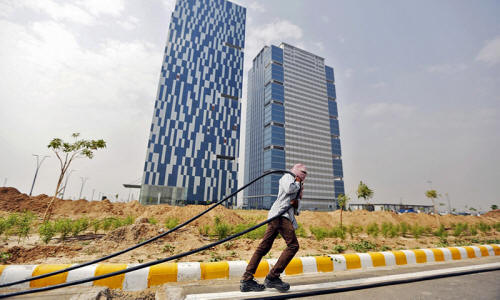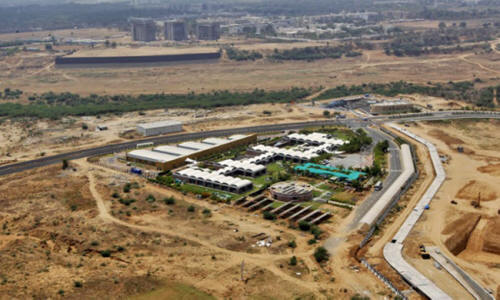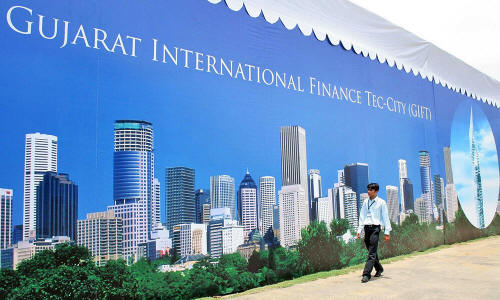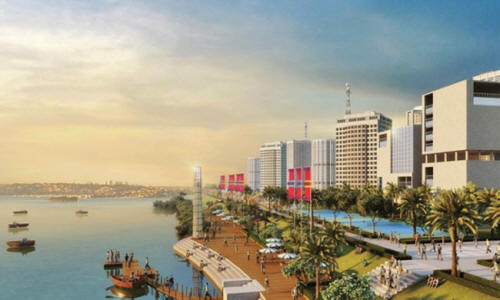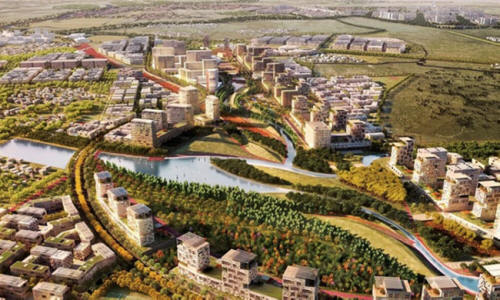In architectural renderings, Gujarat International Financial Tec-City (GIFT City) resembles a thicket of glassy blue skyscrapers soaring above the Sabarmati River in Gandhinagar, capital of the western Indian state of Gujarat.
Its "signature towers" include the Diamond, a 410-metre spire resembling an icy stalagmite, and the 362m Gateway Towers, a bendy, sinuous version of Rem Koolhaas's CCTV headquarters in Beijing.
By 2021, the creators of Gift City, as it is commonly known, promise to surround these towers with world-class infrastructure which will provide residents with round-the-clock power and water, a "district-cooling system" that sluices chilled water through buildings, and an automatic garbage disposal system sending excrement hurtling through sewage pipes at 90kph - "faster than most Indian trains", as the journalist Manu Joseph dryly observed.
The beating heart - or rather, robot brain - of Gift City is its "Command and Control Centre", which keeps traffic moving smoothly and monitors every building through a network of CCTVs.
In a country where more than 300 million people live without electricity, and twice as many don't have access to toilets, Gift City's towers sound like hypertrophic castles in the sky.
But they are an essential part of the Indian government's urban vision, one that it wants to see replicated a hundred times across the country.
Recently, the Indian cabinet green-lit a £10 billion scheme that will be divided equally between building 100 smart cities, and rejuvenating another 500 cities and towns over the next five years.
Yet many experts and planners fear that such "insta-cities", if they are made, will prove dystopic and inequitable.
Some even hint that smart cities may turn into social apartheid cities, governed by powerful corporate entities that could override local laws and governments to "keep out" the poor.
In a monograph for a conference on Smart Cities in Mumbai in January, the economist and consultant Laveesh Bhandari described smart cities as,
"special enclaves" that would use prohibitive prices and harsh policing to prevent "millions of poor Indians" from "enjoying the privileges of such great infrastructure".
"This is the natural way of things," he noted, "for if we do not keep them out, they will override our ability to maintain such infrastructure."
Bhandari's bald statements sparked social-media pandemonium, and the economist is now at pains to assert he is far from uncritical of such plans.
"I am describing the unfeasibility and undesirability of a thoughtless smart-city vision," he says.
"When you invest so much without thinking about services and low-cost housing and governance, then you will end up creating enclaves that keep out the poor."
In their present form, Bhandari adds, smart cities are essentially rechristened Special Economic Zones (SEZs); neo-liberal business-friendly zones exempt from taxes, duties and stringent labour laws.
They are also subject to what urban scholars say is a form of "privatized governance", due to a constitutional amendment that renders local governments powerless.
All of which, according to Bhandari, makes them inherently and unreservedly exclusionary.
"The current template for smart cities only mandates infrastructure creation. What we need is democracy and rule of law, not governance by fiat that holds in SEZs and smart cities created in China."
Last July, Narendra Modi's newly elected government allocated 70.6 billion rupees (£762m) to its "100 Smart Cities" plan.
This year's allocation shrank to 1.4bn rupees, yet smart cities remain a key justification for a controversial land-acquisition ordinance the government is aiming to enact, which does away with mandatory consent and social safeguards for those whose lands are forcibly acquired.
Over the past few months, smart city-themed conferences have been taking place every week in Delhi and Mumbai, culminating in the urban development minister Venkaiah Naidu's announcement that the scheme would be "rolled out" imminently.
Yet no one is quite sure of what these cities might look like, or who they're for. Naidu, with not a little wistfulness, said that smart cities,
"would have clean water, assured power supply, efficient public transport and would not be polluted or congested".
A concept note from his ministry, last revised in December, explains that they will,
"have smart (intelligent) physical, social, institutional and economic infrastructure", guaranteeing their residents employment opportunities and "a very high quality of life, comparable with any developed European city".
This repeated emphasis on high-end infrastructure and superlative quality of life hints at a discomfiting answer to the second question: who the intended inhabitants of smart cities are likely to be.
The current template might have given us Palava City.
This self-described smart city across 3,000 acres of Mumbai's northeastern exurbs is being built by a city-based developer best known for treating skyscraper-erecting as a competitive sport. As its promotional video announces in a smug baritone, Palava City was inspired by the futuristic vision that brought Singapore, Dubai "and even Mumbai" into being.
What this translates into is "essential public infrastructure" such as 24x7 electricity, immaculate wide roads, public transport, malls, multiplexes and luxury housing, including "Mumbai's first and only golf-course-equipped residential township".
To make sure that no one trespasses on its immaculate privatopia, Palava plans to issue its residents with "smart identity cards", and will watch over them through a system of "smart surveillance".
The emphasis on surveillance underlines the stratified, elitist nature of smart cities, according to the academic and author Pramod Nayar.
"Smart cities will be heavily policed spaces," he says, "where only eligible people - economically productive consumers (shoppers) and producers (employees) - will be allowed freedom of walking and travel, while ambient and ubiquitous surveillance will be tracked so as to anticipate the 'anti-socials'."
As such, Nayar adds, smart cities will be,
"more fortresses than places of heterogeneous humanity, because they are meant only for specific classes of people".
One class to be served, the other to be surveilled and contained.
"The smart city paradigm comes from mid-scale European cities, and they're meant to make existing infrastructure work in a more integrated way, whether it's waste, habitation or transport connectivity," says Gautam Bhan, a researcher with the Indian Institute for Human Settlements in Delhi.
"But Indian cities struggle with the absence of networks. Just 16% of Indian cities have underground sewage drainage systems. No technology can make the system work better if basic services don't exist."
Set against this context, Gift City, which models itself after financial hubs Canary Wharf in London and Paris's La Defense, starts to resemble the Emerald City, a glittering spectacle at the end of a shiny highway.
In India such cities - geared towards high-end services - seem unlikely to provide many meaningful livelihood opportunities in the rural hinterlands where they come up.
"Having islands of well-serviced smart cities amidst a vast sea of poorly-serviced and impoverished villages leads to what urban scholars have called the juxtaposition of the citadel and ghetto," says Sai Balakrishnan, an urban scholar at Rutgers, who studies land conflicts and urbanization in India.
"If the government does succeed in building these premium 100 smart cities, but does nothing to alleviate poverty and poor services in the surrounding areas, it could well lead to a politically volatile situation. These visible forms of spatial inequalities engender social mistrust and even violence."
Nowhere is this combination of political volatility and spatial inequality more striking than in the giant expressway projects snaking across the country's hinterland since 2006.
These six-to-eight lane highways, intended to thread together luxury townships and special economic zones, often come up on fertile farmland that is forcibly acquired under the pretext of fulfilling a "public purpose".
In May 2011, one such project just outside Delhi - involving an expressway, private sports-themed city, and the country's first Formula 1 racetrack - led to months-long protests among farmers from 10 villages.
The rally descended into violence when villagers clashed with armed police, leading to the deaths of two farmers and two policemen (read also
Not all manifestations of disquiet end in gunshots and death, however.
Balakrishnan recounts an incident that took place on the outskirts of Bangalore, where villages are rapidly being replaced with IT parks, gated communities and wealthy villas.
A friend returned to her "visibly opulent" bungalow one evening to find a young man lounging on her porch, drinking a cold beer from her fridge. When she took out her phone to call the police, he brandished a small knife and motioned for her to sit down.
She did, upon which he finished his beer, thanked her politely and left.
"This incident makes palpable the sense of resentment and alienation among those excluded from partaking in India's new urban wealth," Balakrishnan says.
"The young man wasn't out to harm anyone, but he felt justified, entitled almost, to break into an affluent home and to help himself to a few hours of luxury."
Every new smart city, she suggests, signals yet another,
"temporary secession, each of them setting in place a new social order that will not be easy to reverse, and that takes urban planning dangerously away from the public domain".
A hundred smart cities could spawn a thousand shadow cities, simmering with resentment and rage.

